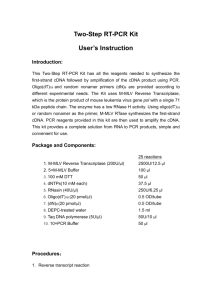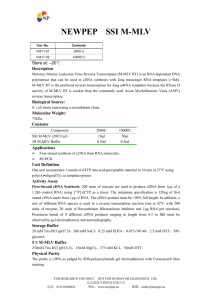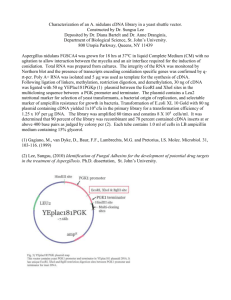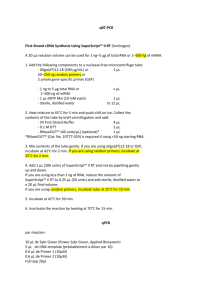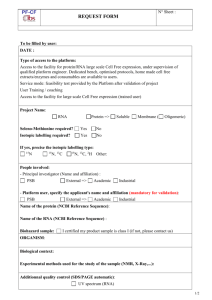First-Strand cDNA Synthesis Kit
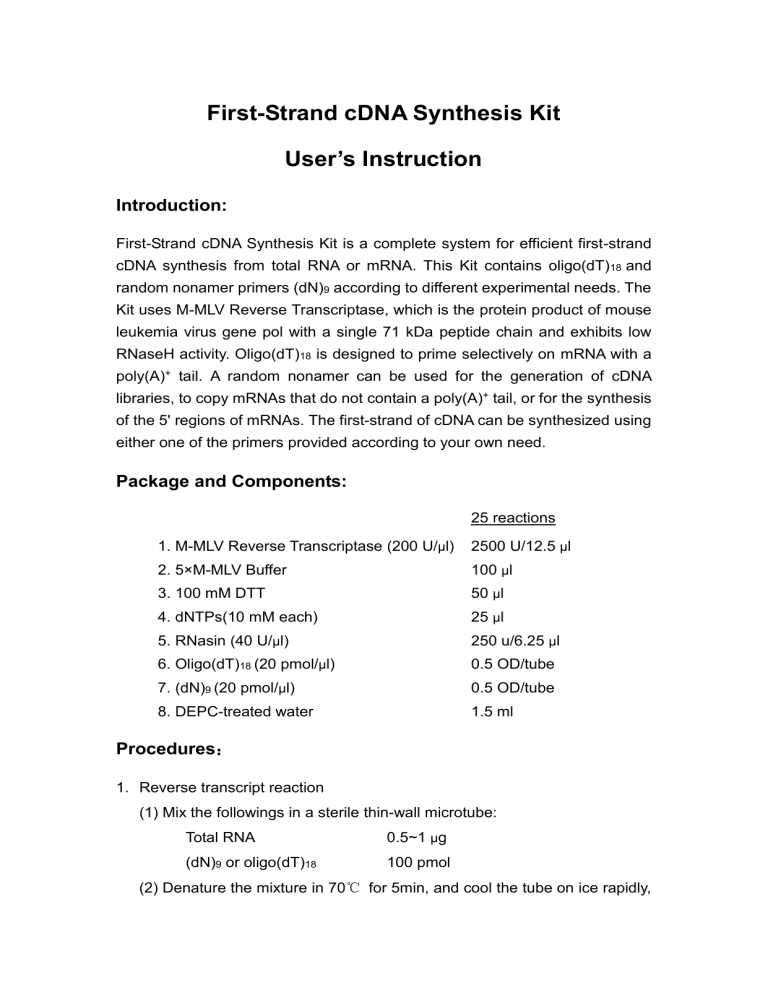
First-Strand cDNA Synthesis Kit
User’s Instruction
Introduction:
First-Strand cDNA Synthesis Kit is a complete system for efficient first-strand cDNA synthesis from total RNA or mRNA. This Kit contains oligo(dT)
18 and random nonamer primers (dN)
9
according to different experimental needs. The
Kit uses M-MLV Reverse Transcriptase, which is the protein product of mouse leukemia virus gene pol with a single 71 kDa peptide chain and exhibits low
RNaseH activity. Oligo(dT)
18
is designed to prime selectively on mRNA with a poly(A) + tail. A random nonamer can be used for the generation of cDNA libraries, to copy mRNAs that do not contain a poly(A) + tail, or for the synthesis of the 5' regions of mRNAs. The first-strand of cDNA can be synthesized using either one of the primers provided according to your own need.
Package and Components:
25 reactions
1. M-MLV Reverse Transcriptase (200 U/ µ l) 2500 U/12.5 µ l
2. 5 ×M-MLV Buffer 100 µ l
3. 100 mM DTT
4. dNTPs(10 mM each)
5. RNasin (40 U/ µ l)
6. Oligo(dT)
18
(20 pmol/ µ l)
7. (dN)
9
(20 pmol/ µ l)
50 µ l
25 µ l
250 u/6.25 µ l
0.5 OD/tube
0.5 OD/tube
8. DEPC-treated water 1.5 ml
Procedures
:
1. Reverse transcript reaction
(1) Mix the followings in a sterile thin-wall microtube:
Total RNA 0.5~1 µ g
(dN)
9
or oligo(dT)
18
100 pmol
(2) Denature the mixture in 70 ℃ for 5min, and cool the tube on ice rapidly,
then add the following components:
5
×M-MLV Buffer dNTPs(10 mM each)
RNasin
100 mM DTT
4
1
µ
µ l l
10 u
2 µ l
M-MLV Reverse Transcriptase 100 U
DEPC- treated water up to 20 µl
(3) Mix the solution and centrifuge briefly, then incubate for 1 hr at the appropriate temperature: 42 ℃ for using oligo(dT)
18 primers, and 37 ℃ for that using (dN)
9 primers.
(4) Stop the reaction by incubating at 94 ℃ for 5 min and cool the tube on ice.
(5) The cDNA synthesized using this system can be used directly in PCR amplification or other downstream applications.
2. PCR amplification (Optional)
(1) Mix followings in a sterile thin-wall microtube:
Synthesized cDNA
10 ×PCR B uffer
Forward primer
Reverse primer dNTPs(10 mM each)
Taq DNA Polymerase ddH
2
O
1-3 µ l
2 µ l
10 pmol
10 pmol
0.5 µl
1.5 U up to 20 µ l
(2) Mix the solution and centrifuge briefly, then begin the PCR amplification:
Denature the template at 94 ℃ for 2.5min. Then enter the following cycles for 30~40 times (this amplification parameter is just for reference): 94 ℃ 30s, 60 ℃ 45s, 72 ℃ 1~3min. Extend at 72 ℃ for
7min lastly.
Remarks:
1. Ensure the integrity and purity of your RNA. The quality of RNA is the key for first-strand cDNA synthesis. The integrity and purity of RNA can be inspected by the ratio of OD
260
/OD
280
and agarose gel analysis. The
common ratio of purified RNA is 1.8~2.0, if not, the RNA should be purified further. The ratio of eukaryotic RNA 28S/18S is about 2:1, if not, the RNA has been degraded.
2. Avoid RNase contamination. All vessels, reagents and solutions must be sterile, and all procedures must be carried out with gloves.
3. Select the right primers for first-strand cDNA synthesis. Primer oligo
(dT)
12-18 can ensure the synthesized cDNAs have intact 3 ’-end, and get the first-strand cDNA close to full length. Primer (dN)
6
or (dN)
9 can anneal to many sites of the mRNA, and produce short length first strand cDNA segments, which is often used to acquire 5
’-end sequence and to obtain cDNA from RNA with secondary structure or stop site that stops the reverse transcription.
Troubleshooting Guide
1. Why the yield of cDNA is low?
Possible causes: (1) The quality of template RNA was too low. (2) The concentration of RNA was estimated too high. (3) Reverse transcriptase inhibitor existed or reverse transcriptase was insufficient. (4) Reaction volume was too large. The common volume should not be more than 50 µl.
2. Why the long cDNA can ’t be synthesized?
(1) RNA has been degraded: all vessels and reagents should be sterile and treated with DEPC to avoid RNase. At the same time, RNase inhibitor should be added into the reverse transcription reaction.
(2) I mproper reaction condition: condition can be optimized, including quantity of reverse transcriptase, salt concentration, reaction temperature (37~56 ℃ ) and concentration of DTT (0.5~10mM).
(3) Secondary structure of RNA: increase reaction temperature or use random primer.


